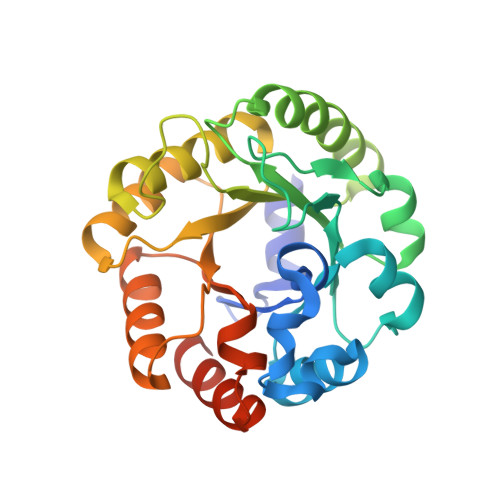Mechanism of the Schiff base forming fructose-1,6-bisphosphate aldolase: structural analysis of reaction intermediates.
Lorentzen, E., Siebers, B., Hensel, R., Pohl, E.(2005) Biochemistry 44: 4222-4229
- PubMed: 15766250
- DOI: https://doi.org/10.1021/bi048192o
- Primary Citation of Related Structures:
1W8S, 2YCE - PubMed Abstract:
The glycolytic enzyme fructose-1,6-bisphosphate aldolase (FBPA) catalyzes the reversible cleavage of fructose 1,6-bisphosphate to glyceraldehyde 3-phosphate and dihydroxyacetone phosphate. Catalysis of Schiff base forming class I FBPA relies on a number of intermediates covalently bound to the catalytic lysine. Using active site mutants of FBPA I from Thermoproteus tenax, we have solved the crystal structures of the enzyme covalently bound to the carbinolamine of the substrate fructose 1,6-bisphosphate and noncovalently bound to the cyclic form of the substrate. The structures, determined at a resolution of 1.9 A and refined to crystallographic R factors of 0.148 and 0.149, respectively, represent the first view of any FBPA I in these two stages of the reaction pathway and allow detailed analysis of the roles of active site residues in catalysis. The active site geometry of the Tyr146Phe FBPA variant with the carbinolamine intermediate supports the notion that in the archaeal FBPA I Tyr146 is the proton donor catalyzing the conversion between the carbinolamine and Schiff base. Our structural analysis furthermore indicates that Glu187 is the proton donor in the eukaryotic FBPA I, whereas an aspartic acid, conserved in all FBPA I enzymes, is in a perfect position to be the general base facilitating carbon-carbon cleavage. The crystal structure of the Trp144Glu, Tyr146Phe double-mutant substrate complex represents the first example where the cyclic form of beta-fructose 1,6-bisphosphate is noncovalently bound to FBPA I. The structure thus allows for the first time the catalytic mechanism of ring opening to be unraveled.
Organizational Affiliation:
European Molecular Biology Laboratory, Hamburg Outstation, Germany.















